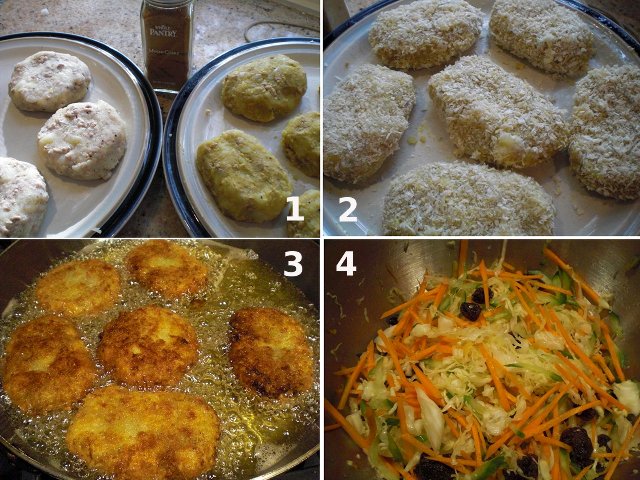I am not sure how and when "
croquette" or korokke
コロッケ was introduced to Japan but according to
Wikipedia Jpn, the potato croquette recipe was first published in 1872 although the name "korokke" was not used then. This was, amazingly, a mere 4 years after Japan opened to the West! It was assumed that the original croquette was a French dish based on Béchamel sauce rather than mashed potato. (This type of croquette is referred as "cream" croquette クリームコロッケ in Japan). Dishes made from the combination of ground meat and a starch appear in so many cultures with "
cottage" or "shepard's" pie being best known in the United States.
Potato croquettes have been a part of Japanese food culture for a long time. Actually, it is considered a very cheap and lowly side dish. As such, there is a famous song called "song of croquette"
コロッケの唄 which was reportedly popular around 1917. Obviously that was way before I was even born but when I lived in Japan, I knew about the song and even heard it sung. The lyrics go something like "Glad to have gotten married but my wife serves croquettes today and croquettes tomorrow and croquettes all year long". Potato croquettes are generally not made from scratch at home. Instead it is usually bought either at "side dish" stores or "zousai-ya" 惣菜屋 or at the basement gourmet food floor of Japanese department stores ("
depachika" デパ地下). It can also be bought frozen at any supermarket and then just fried at home. It is almost never served in regular restaurants but is a common item in a very low-key eatery called "Taishu shokudou" 大衆食堂 or "commoner's eatery" and Izakaya. I meant to make this for some time but finally, got around to it.

The ingredients below made about ten 3x2 inch flat patties.
Meat: Any ground meat will do but I happened to have trimmings from pork tenderloins. I hand chopped it, which turned out to be a bit over 300 grams. I first sautéed finely chopped onion (1 medium) in olive oil. I then added the ground pork and cooked until the meat was done. I seasoned it with salt and pepper.
Potate: I skinned and quartered white potatoes (5-6, small to medium) and microwaved it in a silicon microwave steamer for 5-6 minutes or until done.
I mashed the potatoes while they were hot. I divided the mashed potato and the meat mixture into two bowls. In one bowl, I added curry powder (an American variety since I was out of my regular Japanese curry powder) to taste (about 1 tsp) and salt. I seasoned the second bowl of pork and potatoes with salt and black pepper. I mixed both well and adjusted the seasoning (more curry powder and salt). Using a medium-sized ice cream scoop, I apportioned the two mixtures and put them on separate plates. Using wet hands to keep the mixture from sticking, I made the curry flavored ones into oval flat shapes (Right in #1 image below). This shape is called "
koban" 小判 since it resembles one of the gold coins in Edo era. I made the salt and pepper flavored ones into flat round disks (left in #1 image below). The different shapes are just so I could distinguish the curry flavored ones from the other kind. Since I was not planning to deep fry this (I shallow fried), it is important to make it into a thin disk rather than a cylinder shape. You could add cooked small cubes of carrot, green peas etc in this if you wish.

I let them cool a bit so that they could harden and be easier to handle. I then dredged in flour, egg water and panko Japanese bread crumbs (#2 above). Instead of deep frying, I shallow fried using light olive oil of about half inch deep (#3). My wife asked why I used olive oil. I do not have any reason. Vegetable or peanut oil will also do. Since the ingredients are all cooked, I fried rather briefly; until it became golden brown and a nice crust formed, turning once (1-2 minutes each side).
Accompaniment: Traditional Japanese accompaniment is, as usual for any fried food, shredded raw cabbage but I made a sort of Japanese style coleslaw with thinly julienned carrot, cucumber and raisins (#4). I simply dressed it with a mixture of Dijon whole grain mustard and mayonnaise (1:3 ratio) and seasoned it with salt and pepper.
Here are the cut surfaces of the two kinds of croquettes. The upper one is curry flavored and the lower one is seasoned with salt and pepper.
Both are very good. You cannot go wrong with a combination of mashed potato, ground meat, and onion which are fried! I served this with Japanese semi-thick
Tonkatus sauce と んかつソースwhich is also very common way to serve potato croquettes in Japan. I remember that the croquettes I liked as a kid were curry flavored. As an adult, I like the curry flavored one as well. Although my wife does not have such a memory, she also liked the curry flavored. Although the curry flavored potato/meat mixture tasted rather spicy before I cooked it, once it was fried, it was just pleasantly spicy and actually turned out to be rather mild.
For drinks, anything goes. Beer, sake (cold) even wine either red or white are just fine with this.

